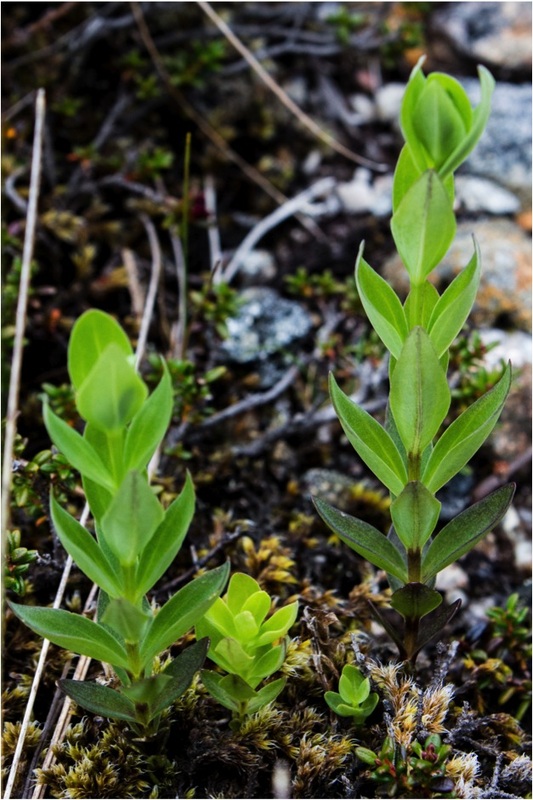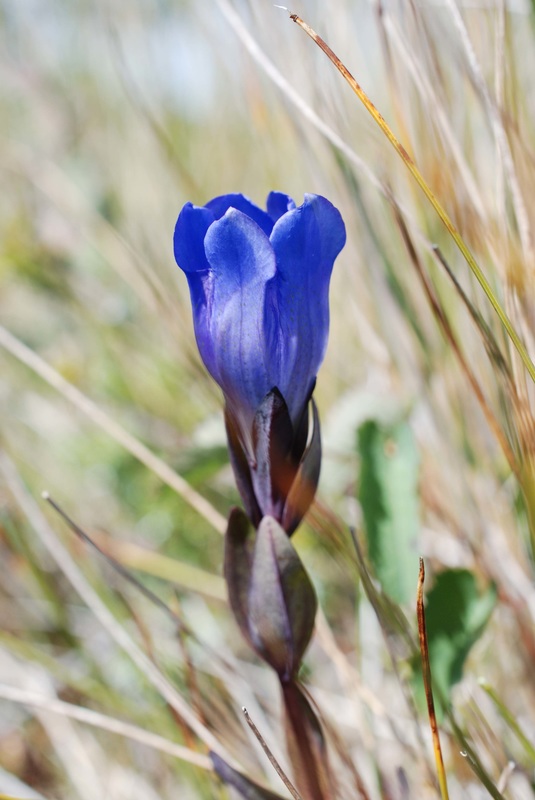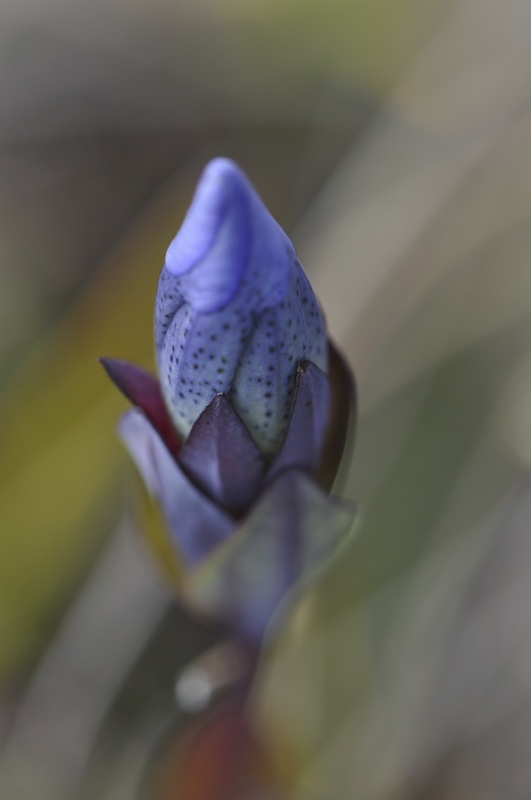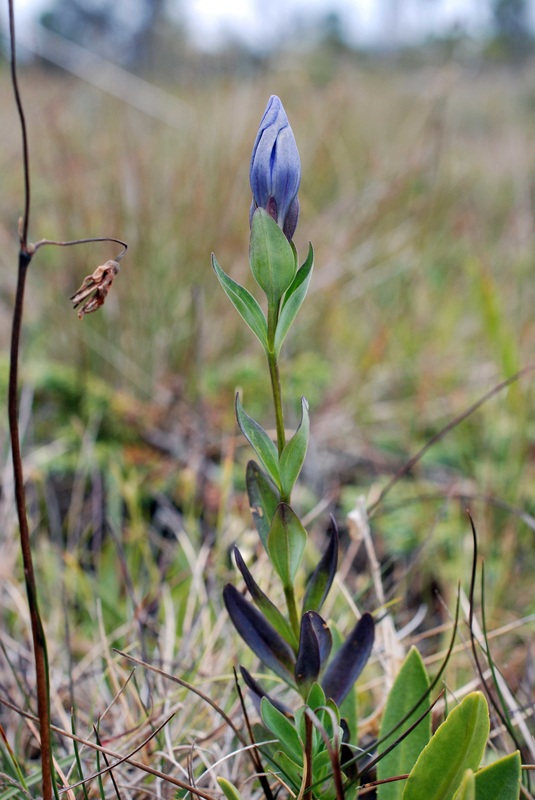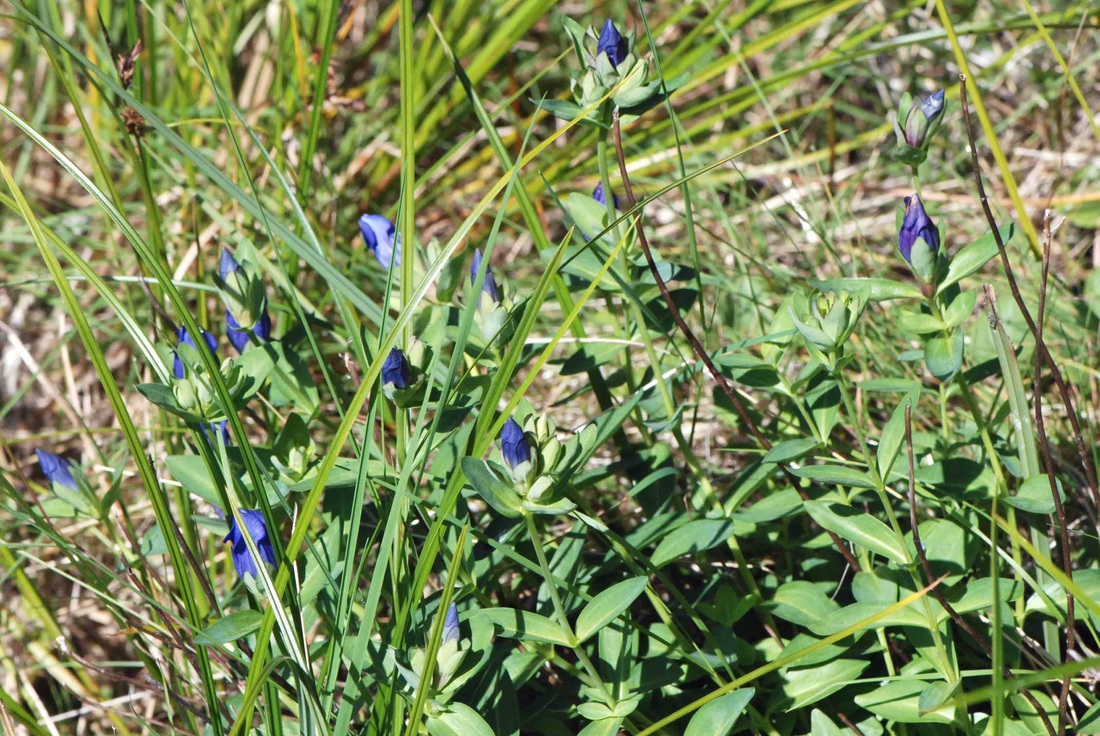King gentian, king's sceptre gentian • Gentiana sceptrum
{Gentiana = from Gentius, an Illyrian king; sceptrum = sceptre, based on the appearance of the flowers}
|
King gentian growing individually or in small groups in bogs (top, bottom left) and clustering beside a pond (bottom right). Photos by Cody Gold (top left), Kira Hoffman (top right), and Kelly Fretwell.
|
Identification
King gentian is a leafy perennial species that typically grows in clusters and can get up to 1 m tall. Its oblong to lance-shaped leaves grow in opposite pairs along the stem. The upper leaves are largest, with the lower leaves becoming short bracts. It has large ( to 4.5 cm tall) blue flowers that may be marked with green streaks or spots. The flowers are tube- or funnel-shaped and composed of 5 flared lobes, with folds or pleats between the lobes. The flowers have short stalks and typically grow in clusters at the top of a stem.
Habitat & Range
King gentian grows at low elevations in wet habitats such as bogs, wet meadows, and along lakes. It is a common species, particularly in coastal areas of southern BC. It is less common north of Vancouver Island and the adjacent coast. Its ranges stretches from BC to northern California.
Similar Species
Mountain bog gentian (Gentiana calycosa) grows in similar habitats at high elevations (the Cascade and Olympic mountains), and has stalkless flowers that grow individually atop stems. Its flowers have frilled pleats between petal lobes. Broad-petalled gentian (G. platypetala) is smaller, and has solitary and stalkless flowers with petals fused into two lips with 5 teeth instead of 5 lobes. It is rare along the mainland coast of BC north of Vancouver Island.
King gentian is a leafy perennial species that typically grows in clusters and can get up to 1 m tall. Its oblong to lance-shaped leaves grow in opposite pairs along the stem. The upper leaves are largest, with the lower leaves becoming short bracts. It has large ( to 4.5 cm tall) blue flowers that may be marked with green streaks or spots. The flowers are tube- or funnel-shaped and composed of 5 flared lobes, with folds or pleats between the lobes. The flowers have short stalks and typically grow in clusters at the top of a stem.
Habitat & Range
King gentian grows at low elevations in wet habitats such as bogs, wet meadows, and along lakes. It is a common species, particularly in coastal areas of southern BC. It is less common north of Vancouver Island and the adjacent coast. Its ranges stretches from BC to northern California.
Similar Species
Mountain bog gentian (Gentiana calycosa) grows in similar habitats at high elevations (the Cascade and Olympic mountains), and has stalkless flowers that grow individually atop stems. Its flowers have frilled pleats between petal lobes. Broad-petalled gentian (G. platypetala) is smaller, and has solitary and stalkless flowers with petals fused into two lips with 5 teeth instead of 5 lobes. It is rare along the mainland coast of BC north of Vancouver Island.
References
Gentiana sceptrum Griseb. In Klinkenberg, Brian. (Ed.). E-Flora BC: Electronic Atlas of the Plants of British Columbia. Lab for Advanced Spatial Analysis, Department of Geography, University of British Columbia, Vancouver. Accessed 16/04/2014.
Pojar, J. and MacKinnon, A. (1994). Plants of Coastal British Columbia. Vancouver, BC: Lone Pine Publishing. P. 228.
Authors and editors of page
Kelly Fretwell and Brian Starzomski (2014).
Gentiana sceptrum Griseb. In Klinkenberg, Brian. (Ed.). E-Flora BC: Electronic Atlas of the Plants of British Columbia. Lab for Advanced Spatial Analysis, Department of Geography, University of British Columbia, Vancouver. Accessed 16/04/2014.
Pojar, J. and MacKinnon, A. (1994). Plants of Coastal British Columbia. Vancouver, BC: Lone Pine Publishing. P. 228.
Authors and editors of page
Kelly Fretwell and Brian Starzomski (2014).
